7
Hybrid and Electric Powertrain Technologies
7.1 INTRODUCTION
The quest to reduce fuel consumption and greenhouse gas emissions of vehicles has generated significant interest in electrification and hybridization of powertrains and other vehicle systems. Various government programs for vehicle efficiency have been in place during the commercialization of hybrid electric vehicles in the light-duty sector, such as the Toyota Prius. At the national level, the Corporate Average Fuel Economy program has been in place since the 1970s (NRC, 2015). The State of California has its Zero Emission Vehicle Standard.1 The federal government supports research and development of relevant technologies. Specifically, a significant portion of the U.S. Department of Energy’s (DOE’s) vehicle technology budget (>$2 billion) has been devoted to hybrid, electric, and battery technology development over the past 10 years, primarily directed toward light-duty vehicles.2 To a lesser extent, DOE has supported research and development in the application of electric powertrains and related systems through their 21st Century Truck Partnership activity under the Vehicle Technologies Office within the Office of Energy Efficiency & Renewable Energy (EERE).
The Environmental Protection Agency (EPA), National Highway Traffic Safety Administration (NHTSA), and California Air Resources Board have all published rules, proposed rules, and performed regulatory impact analyses that show a significant penetration of hybrid, plug-in hybrid, and battery electric vehicles is required in order to meet future light-duty vehicle fuel economy and greenhouse gas (GHG) emission standards, despite lackluster sales of hybrid and electric vehicles. For example, the segment-leading Toyota Prius saw its sales reach 236,000 units in 2012 only to decline to 136,000 in 2016.3 Unfortunately, due to the difference in vehicle size, weight, duty cycle, and the energy necessary to propel the vehicles, the market application of electrification and hybridization technology to commercial vehicles significantly lags that of passenger vehicles for reasons discussed below.
7.1.1 Hybrid Powertrains and Uses
The term “hybrid” refers to the combination of two or more energy conversion sources. A typical hybrid electric system includes an internal combustion engine (ICE) and an electric motor/generator system that can
___________________
1 See https://www.arb.ca.gov/msprog/zevprog/factsheets/zev_tutorial.pdf (accessed December 1, 2019).
2 See https://energy.gov/eere/budget/past-and-present-eere-budget (accessed December 1, 2019).
3 See http://carsalesbase.com/us-car-sales-data/toyota/toyota-prius/ (accessed December 1, 2019).
extract energy in the form of electricity from a battery to propel the vehicle. The battery system can also store the energy that has been recovered during braking or from the excess power generated by the ICE while running in a high-efficiency point. Other hybrid systems employ different combinations of energy conversion devices such as an ICE and a hydraulic pressure accumulator storage system or a fuel cell propulsion energy system combined with an ultra-capacitor to store high levels of electric power transferred during vehicle braking and subsequent launch.
The goal of a hybrid propulsion system is to manage energy flows most efficiently throughout the drivetrain system, thereby reducing fuel consumption and GHG emissions, by
- Allowing the engine to be turned off during inefficient operating conditions, such as idling, and to be restarted very quickly when necessary (stop-start);
- Operating the engine as efficiently as possible by running it near the curve of highest efficiency as much as practicable;
- Following functional control strategies that supplement the engine power during periods of acceleration (launch assist), which can reduce enrichment or transient control approaches that increase fuel consumption, due to the excellent low-speed torque characteristics of electric motors;
- Providing supplemental power and launch assist, which also offers the possibility to down-size the ICE while maintaining equal performance, so long as operational strategy maintains sufficient state of charge in the battery;
- Operating the vehicle accessories, such as air conditioning compressors or power steering pumps, independent of engine speed, which allows both vehicle operation while the engine is not running and the possibility to operate the accessories at closer to peak efficiency points;
- Using batteries and drive motors to support the potential for other forms of energy transfer, such as generation of electric current via waste-heat recovery systems (NHTSA and EPA, 2016) or the adaptation of fuel cells;
- And, perhaps most importantly, using hybrid systems, both electrical and hydraulic (discussed below), which allow a mechanism to store energy that is normally lost to heat during braking, that can be recovered and applied during subsequent acceleration of the vehicle (regenerative braking). The significance of regeneration becomes apparent when one considers that approximately 60 percent of the total energy spent in the Federal Urban Driving Schedule (FUDS) is used to overcome the effect of inertia and that, theoretically, up to 50 percent of this energy could be recovered (NRC, 2015).
7.1.2 Hybrid Vehicle Architectures
The National Research Council (NRC, 2010a) report Technologies and Approaches to Reducing the Fuel Consumption of Medium- and Heavy-Duty Vehicles provides a complete and exhaustive description of the various forms of hybrid vehicle architectures which are applied to light-, medium-, and heavy-duty vehicles. Since this NRC Phase One Report was published, there have been no significant changes in overall architecture, although the costs, system efficiencies, and results of recent DOE SuperTruck research programs are included within the present report as an update and state-of-the-art statement.
7.1.2.1 Series Hybrid Electric Powertrains
In a series hybrid electric vehicle (HEV), a generator, coupled to an ICE, supplies electricity to the electric motor to propel the vehicle and/or to the energy storage system for recharging the battery. Normally, the engine/generator charges the energy storage system to between 50 and 70 percent for charge sustainability.
As shown in Figure 7-1, in this configuration only the electric motor is mechanically connected to the wheels; the engine is decoupled. Consequently, the engine can run near its best efficiency zones and it never idles, thereby reducing fuel consumption. However, the engine/generator set must be sized for sustained gradeability. Therefore, a sufficiently large energy storage system pack (needed so as not to cycle the engine on and off too frequently), an electric generator and a separate electric motor, sufficiently large to propel the vehicle, and an engine of sufficient power for performance and gradeability are required.
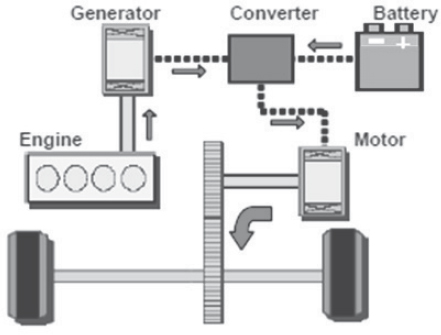
SOURCE: NRC (2010a).
For this system to be viable, it must possess an overall high efficiency in total power processing. While the added mass and the component inefficiencies make that configuration unlikely for small trucks, it is more viable for large vehicles, such as buses, which are less sensitive to increases in overall weight. The elimination of the mechanical driveshaft can be an important advantage of adopting the series configuration.
7.1.2.2 Parallel Hybrid Electric Powertrains
Parallel hybrids have mechanical connections to the wheels from both the motor/generator and the engine, as illustrated in Figure 7-2. The motor/generator can be positioned in any of multiple locations between the output shaft of the ICE and the wheels. Unlike the series HEV configuration, a single motor/generator unit can be used to drive the wheels or generate electricity during regenerative braking to recharge the battery.
In a parallel HEV, the motor/generator can supplement the ICE during start-up or vehicle acceleration because both are coupled to the wheels. Therefore, in theory, the ICE can be reduced in size and power compared to series hybrids unless the intended operational mode requires extended high-power operation, such as climbing a long hill. In some configurations the ICE has the potential to run near its optimum efficiency, with the motor/generator either supplementing the drive power or recharging the battery if all of the ICE power is not needed to drive the wheels. The type of parallel hybrid is normally classified by the size of the motor generator, the amount of time
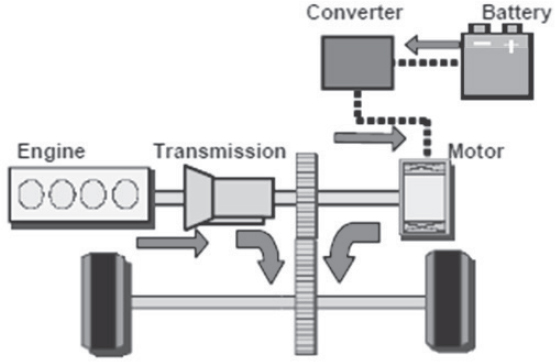
SOURCE: NRC (2010a).
the powertrain can function in electric-only operation (which influences the size of the battery), and the relative power of the electric machine to that of the ICE. Numerous options have been studied for parallel architectures, ranging from micro or mild versions of the starter alternator type to full-featured pre- and post-transmission hybrids, as described below.
7.1.2.3 Micro Hybrid with Stop-Start Capability
In a starter-alternator-type system with stop-start capability, the motor/generator is fixed to the engine output shaft (crankshaft) or connected through a flexible drive system like a chain or belt as shown in Figure 7-3. The main benefit of this system is to shut the engine off while idling. The motor/generator is connected to the engine with a fixed speed ratio, so some very limited level of launch assist is possible, but only up to a very low speed. Also, a certain level of regenerative braking is possible, but it is limited due to the torque transfer capability of the motor/generator drive belt and the size and voltage of the battery. Electrification of climate control accessories (e.g., the air conditioner compressor) is also possible, again depending on the size of the battery. A micro hybrid is typically a 12 to 24 volt (V) system with the maximum power limited to about 4 to 5 kilowatts (kW), although some system suppliers offer a 48 V system that provides a higher level of regenerative energy storage combined with a 7-8 kW motor/generator.4 Energy storage capability is typically in the 1.5 to 3 kilowatt-hour (kWh) range.
7.1.2.4 Mild Hybrid with Stop-Start, Launch Assist, and Regenerative Braking
A starter-alternator-type system may also be designed with somewhat higher power, torque, and energy storage capability. This would classify the system as a mild HEV, although the largest fuel consumption benefit is still derived from stop-start functionality. The system configuration would also be represented by Figure 7-3. In a mild hybrid, the amount of power generated during regenerative braking is increased to about 7 to 12 kW depending on the size of the electric motor, the system voltage, and the battery size. System voltages for mild hybrids which offer higher levels of regenerative braking and some launch assist typically range from 24 to 48 V. The total energy storage capability varies significantly, depending on the weight classification of the vehicle, but is typically in the 3-7 kWh range. Electrification of certain accessories (e.g., the air conditioner compressor, power-steering pump) is also common to assist in driving while the engine is stopped during deceleration and low-speed launch. Many automotive suppliers, including, but not limited to, Delphi, Bosch, and Continental, are pursuing 48 V systems which can be integrated into the belt drive, thereby replacing the conventional alternator. Such systems provide stop-start, regenerative braking, and propulsion launch assist. A 48 V battery stores the recuperated braking energy, which can then be used for torque assist during launch. A direct current converter (DC/DC) steps down the voltage to 12 or 24 V depending on the application.
7.1.2.5 Hybrid Electric Vehicle Pre- and Post-transmission Layouts
Larger energy storage and power parallel hybrid electric vehicles are typically referred to as HEVs and can be designed in pre-transmission and post-transmission configurations. In pre-transmission parallel HEV configurations, the motor/generator is positioned between the transmission and the clutch, as shown in Figure 7-4. This position allows the system to operate in electric drive in low to medium power levels and support engine stop-start operation. Unlike the starter-alternator configuration, the location of the motor/generator before the transmission allows torque multiplication, thereby limiting the maximum speed of the motor/generator and allowing torque assist under high-power conditions.
In post-transmission arrangements, the motor/generator cannot leverage the gear ratios through the transmission. This necessitates high input/output torque over a broad speed range. Such a high torque requirement leads to a larger-size motor/generator compared to the pre-transmission layout, but an energy flow path that is more efficient during regenerative braking. One example of such a configuration is offered by Hino Trucks in its Model 916
___________________
4 See http://www.johnsoncontrols.com/content/us/en/products/power_solutions/products/micro-hybrid1.html (accessed July 2, 2013).
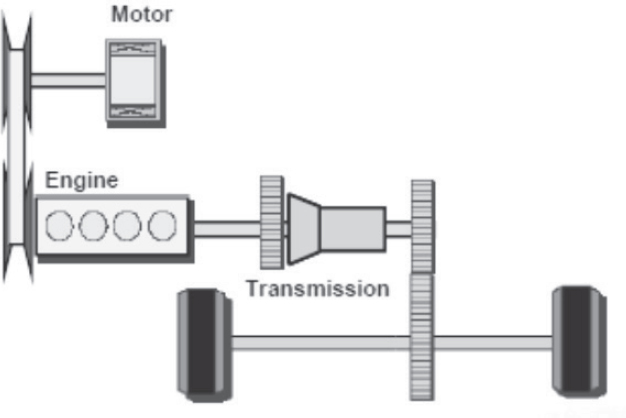
SOURCE: NRC (2010a).
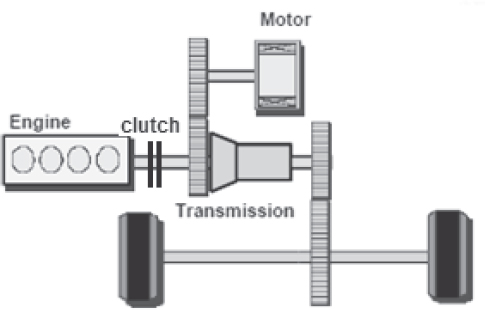
SOURCE: NRC (2010a).
diesel electric hybrid.5 According to Hino, the hybrid system components have been redesigned to reduce weight, reduce volume, and offer improved performance.
With the redesign, Hino has implemented the use of its own “ProShift 5” automated mechanical transmission and relocated the clutch, placing it between the diesel engine and electric motor. This placement of the clutch and traction motor allows electric-only launch. Also, during deceleration, the clutch may be decoupled to maximize the amount of regenerative kinetic energy recovered via the electric generator. All Hino hybrid trucks use a nickel-metal hydride (NiMH) battery for their hybrid driveline systems, which is the same Toyota battery technology that has been used in over 3 million HEVs.
An example of a post-transmission parallel HEV configuration (Figure 7-5) is offered by XL Hybrid, Inc. (Figure 7-6). The XL system is available on a range of new commercial fleet vehicles from Chevrolet, GMC, Ford, and Isuzu. The so-called XL3® Hybrid Electric Drive System is compatible with Class 2, 3, 4, 5, and 6 vans and passenger wagons, commercial vans and shuttles, box trucks, and delivery vans. XL Hybrids reports that installation takes less than 6 hours per vehicle and the performance specifications are as follows:
- System voltage, 259 V;
- Lithium-ion battery, 1.8 kWh;
___________________
5 See http://www.hino.com/hino-trucks-hino-195h.html (accessed December 1, 2019).
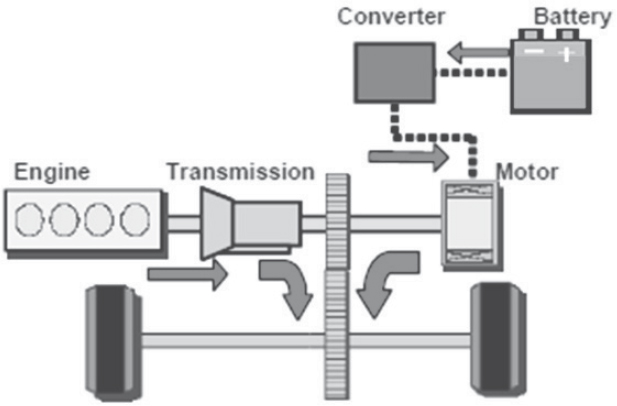
SOURCE: NRC (2010a).
- Hybrid system torque (peak), 220 pound-feet (lb-ft);
- Hybrid system weight, 385 pounds;
- Electronic speed governor up to 85 miles per hour (mph);
- Hybrid component warranty, 3-year / 75,000 miles; and
- Hybrid fuel savings, approximately 25 percent increase in miles per gallon (mpg) or about 20 percent reduction in fuel consumption, depending on drive cycle.
7.1.2.6 Power-Split Hybrid Electric Powertrains
Power-split hybrids combine features of both series and parallel hybrids in an attempt to produce a more efficient drive system. The term “power-split” refers to the ability of the system to “split” the output engine power between two paths: one through a mechanical transmission and drivetrain system to the wheels and another path that drives the generator. Also, regenerative braking can generate electricity through the normal drive motor, which is then stored in the battery or other energy storage system.
An input-split system, shown in Figure 7-7, utilizes an engine, a power-split transmission, a generator, and a drive motor. Operational modes can include
- All engine power through the transmission to drive the wheels if the battery is depleted;
- Partial engine power to the wheels and the remaining engine power to the generator, which charges the battery or energy storage device;
- Engine off and electric power provided to the drive motor from the battery;
- Engine on and additional electric power provided from the drive motor for maximum acceleration; and
- During deceleration and braking, the drive motor acting as a generator and recharging the battery.
During engine starting, electricity powers the generator, thereby causing it to act temporarily as a motor and serving as the “starter motor.” It is interesting to note that generator and separate drive motor, combined with the planetary gear set transmission, “behave as a continuously variable transmission (CVT) whose instantaneous gear ratio depends on the amount of power fed from the generator to the motor” (NRC, 2010a).
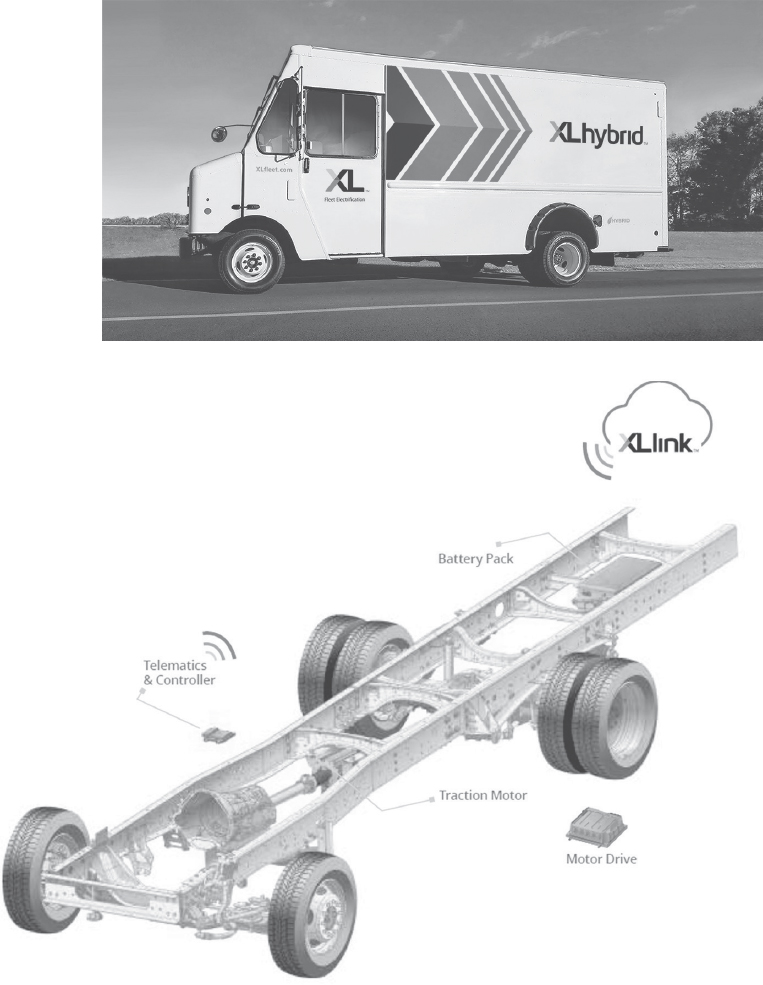
SOURCE: XL Hybrids, Inc. (2018).
Variations of the power split have been implemented, each providing different advantages. These include
- A single-mode power-split hybrid, where the first generator controls engine speed and the drive motor supplements any power needed to propel the vehicle; and
- A dual-mode power-split hybrid with increased complexity but somewhat higher efficiency by minimizing the motor sizes and energy recirculation by using fixed gears.
The reader is again directed to the Phase I report for further details (NRC, 2010a).
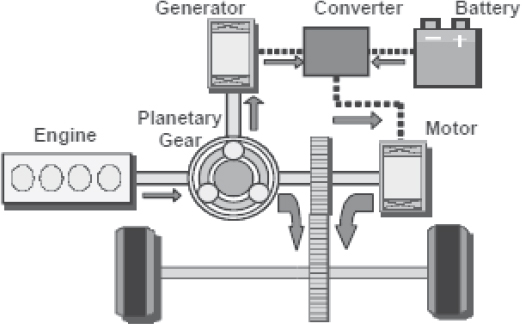
SOURCE: NRC (2010a).
7.1.2.7 Plug-in Hybrid Electric Vehicles
Plug-in hybrid electric vehicles (PHEVs) represent an extension of HEVs with the potential to charge the battery system from the electric power grid. Initially motivated by the potential to reduce local criteria pollutants (smog and health effects pollution) by operating light-duty vehicles over a period of time in electric mode without the ICE engine, local air quality issues have also created interest in PHEV applications for urban medium- and heavy-duty vehicles. PHEVs also offer the potential to replace liquid fuel consumption with grid electric power whereby CO2 and GHG benefits may be realized, depending on the source of the electric power (nuclear, wind, hydro, solar, etc.).
PHEVs gain extended all-electric range with increased size of the battery, determined by goals for electric operation and cost. Since the stored energy must propel vehicles that can range from 10,000 pounds (Class 2b) to 80,000 pounds (Class 8), the size and cost of the battery packs can quickly become prohibitive. As with all hybrid vehicles, the duty cycle has a significant impact on energy efficiency and, for the case of PHEVs, the potential all-electric range. If there are a significant number of braking cycles which allow regenerative braking to recharge the battery, additional range is possible. However, during charge-depleting operation, the high power requirements for acceleration of heavy vehicles can quickly deplete the battery. The time necessary to recharge the PHEV batteries is also an important issue related to battery capacity and power. As discussed in Chapter 8, batteries designed to provide higher power output to propel medium- and heavy-duty vehicles tend to support somewhat faster recharge cycles due to their need to transfer high power relatively quickly. Significant research and development are currently ongoing to address the relatively long time needed to recharge PHEV batteries relative to liquid or gaseous fuels.6 Vehicle manufacturers must undertake trade-off studies to determine the optimum battery size and its associated cost when developing PHEVs. Information concerning cost, size, and complexity of battery systems is presented in Chapter 8.
For medium- and heavy-duty vehicles (MHDVs), there are two general applications in which PHEVs seem most attractive: (1) relatively short-route urban delivery or service applications and (2) vocational vehicles that travel to a job site and then perform operational functions where use of electric power instead of operating the combustion engine can significantly reduce liquid fuel consumption.
An example of the latter application is in electric utility service trucks, sometimes called “bucket trucks.” In such applications, travel to a job site may be followed by many hours of stationary vehicle operation of an extension arm, at the end of which is a worker elevated in a capsule or “bucket.” Two commercial bucket-truck applications are offered by Odyne Hybrid Systems and Efficient Drivetrain, Inc. (Figure 7-8). The Odyne system utilizes the mechanical power-take-off (PTO) of Allison transmissions and is a parallel system configuration.
___________________
6 See https://energy.gov/sites/prod/files/2015/06/f23/es000_faguy_2015_o.pdf (accessed December 1, 2019).
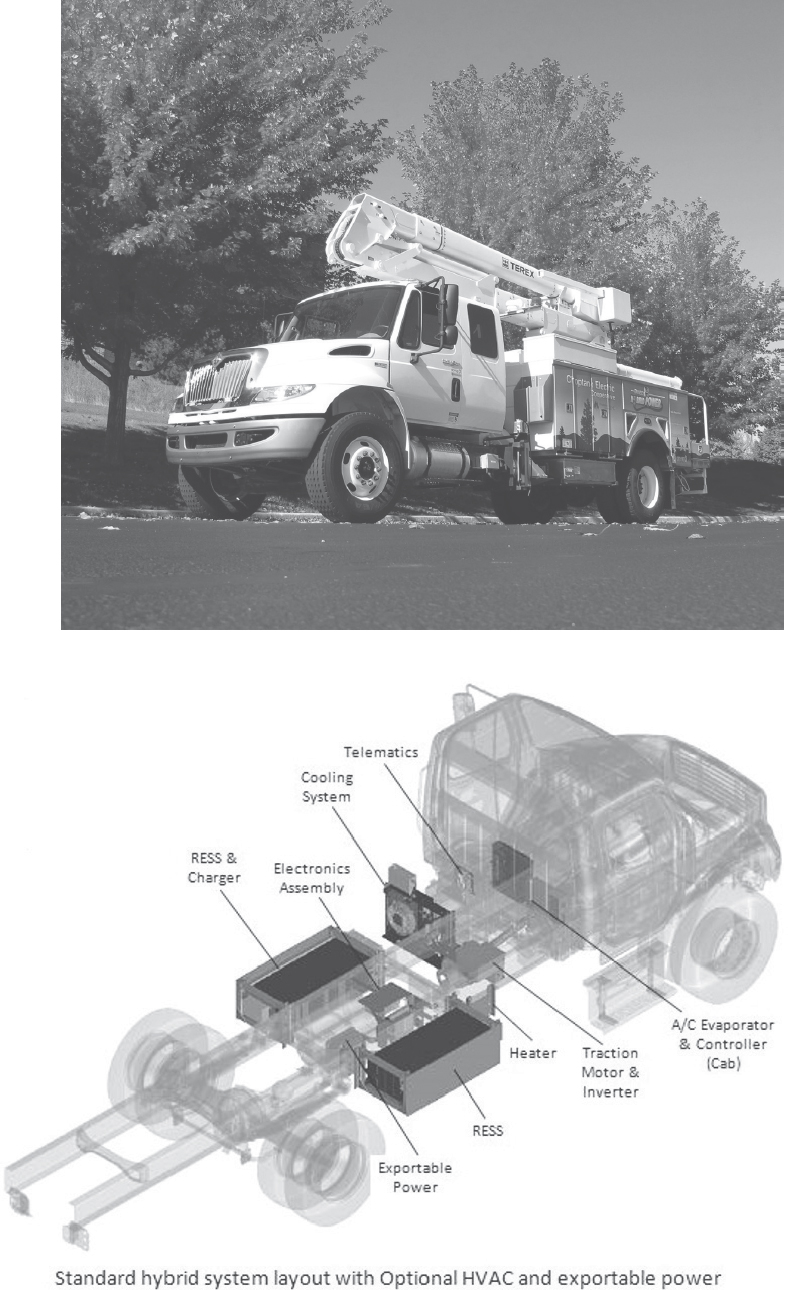
SOURCE: Odyne Hybrid Systems, LLC (2014).
According to Odyne, the vehicle specifications are as follows:
- Stored Energy System: 300 V lithium-ion battery pack with 28.4 kWh capacity.
- Electric Motor: High-power, compact liquid-cooled, permanent magnet motor providing up to 311 Newton-meters (Nm) (232 lb-ft) peak torque with 71 kW peak power and 200 Nm continuous torque and 42 kW continuous power with launch assist while driving and regenerative braking.
- Recharging Capability: Plug-in capability with level two 240 V single-phase III0-amp service to fully recharge the stored energy system within an 8-hour period. Engine-powered recharging while in the field.
- Work-Site Functionality: The engine is automatically started when the stored energy system is depleted and recharged with the vehicle’s engine. Once the stored energy system is recharged, the engine will automatically shut down and the system will resume all-electric stationary mode.
- Inverter Assembly: Liquid-cooled inverter assembly converting the 300 V stored direct current (DC) power to alternating current (AC) power to power permanent magnet motor.
- Liquid-Crystal Display (LCD): Cab-mounted LCD driver display screen providing the operator with valuable plug-in hybrid system data and troubleshooting codes.
- Override: Hybrid override system to allow vehicle to operate as a standard vehicle for driving and stationary application if the PHEV system is not functional.
- Auxiliary Heating and Air Conditioning System: Auxiliary cab heating, ventilation, and air conditioning system for use during all-electric mode while the engine is not running.
- Exportable Power: Frame-mounted inverter assembly providing 6 kW of pure sine wave power.
Efficient Drivetrains, Inc. (EDI) offers a similar product application; however, there are significant differences in the layout and construction of the hybrid powertrain.7 EDI replaces the traditional transmission with a parallel/series system which provides power to the wheels via a separate traction motor driven by the battery or a generator attached to the combustion engine. During regenerative braking, the traction motor acts as a generator and recharges the battery. A unique feature is the functionality of the hybrid drive transmission to mechanically connect the driveshaft to the crankshaft as speed increases. This feature allows the system to have no electrical losses when driving on the highway to, for instance, a job site, thereby maximizing highway fuel economy.
7.1.2.8 Battery Electric Vehicles
Battery electric vehicles (BEVs) represent the complete removal of an ICE, fuel cell, or other energy conversion device, instead only relying on the electric charge in the battery to propel the vehicle. Although the propulsion system is significantly simplified, compared to either series or parallel HEVs, large battery systems are required, especially for MHDVs due to their weights and power/torque requirements for acceptable vehicle performance. Depending on the vehicle weight, BEVs require battery systems that range from about 30 to 40 kWh for a 10,000-pound vehicle (Class 2b) up to over 80 kWh for Class 4 to 6 delivery vehicles. Such applications tend to favor lightweight payloads that cube out (such as snack food delivery vans); centrally, overnight fueled fleets; and local delivery routes that are generally less than 100 miles per day.
As will be discussed in Chapter 8, lithium-ion (Li-ion) battery packs today range in price from about $400/kWh to $600/kWh, depending on the cell chemistry, although General Motors has announced8 that battery cell costs for the Bolt electric vehicle have achieved $145/kWh in 2016 and are approaching $100/kWh at the cell level by 2022, which could suggest battery pack costs which may approach $125/kWh to $135/kWh. However, application for light-duty BEVs are somewhat less rigorous than for commercial vehicles, based on the power transfer requirements. Therefore, commercial viability is still a challenge for commercial electric vehicles due to the large size of the battery packs. However, as discussed in Chapter 8, significant progress in Li-ion costs and reliability offer greater confidence in the commercial viability for certain commercial vehicle applications.
___________________
7 See https://efficientdrivetrains.com/edi-powerdrive/ (accessed May 21, 2019).
8 See http://insideevs.com/gm-chevrolet-bolt-for-2016-145kwh-cell-cost-volt-margin-improves-3500/ (accessed December 1, 2019).
7.1.2.9 Fuel Cell Electric Vehicles
Fuel cells for use as an electric power source in transportation have been under development for over 30 years (DOE, 2015a). Fuel cell buses include fuel cell and fuel cell hybrid systems. In fuel cell systems, the electrical power produced by the fuel cell goes directly to the traction motors which propel the vehicle. In hybrid hydrogen fuel cell configurations, the electric energy is transferred to an energy storage device, such as a battery or capacitor. The electrical power is then transferred to the traction motors. The energy storage device allows brake energy to be recovered as the traction motor(s) operates as a generator during braking. This regenerative braking feature can provide significant improvements in fuel consumption during operating cycles which reflect a high number of acceleration and subsequent braking modes. The federal government has supported hydrogen fuel cell research and development. In fiscal year 2015, Congress appropriated approximately $117 million for the DOE Hydrogen and Fuel Cells Program. In addition, $30 million was appropriated for activities related to solid oxide fuel cells.9 According to DOE, the year 2015 was a landmark year for hydrogen and fuel cells. After decades of research and development (R&D) and the demonstration of various generations of prototype fuel cell electric vehicles (FCEVs) by a number of global automakers, 2015 saw the first commercial FCEVs offered for sale to the general public.
One of the most important fuel cell metrics is the projected high-volume manufacturing cost for automotive fuel cells, which DOE tracks on an annual basis. In 2015, the cost of an 80 kWnet automotive polymer exchange membrane (PEM) fuel cell (FC) system based on next-generation laboratory technology and operating on direct hydrogen was projected to be $53/kWnet when manufactured at a volume of 500,000 units/year (Figure 7-9) and $60/kWnet when manufactured at 100,000 units per year. (For comparison, the expected cost of automotive PEM
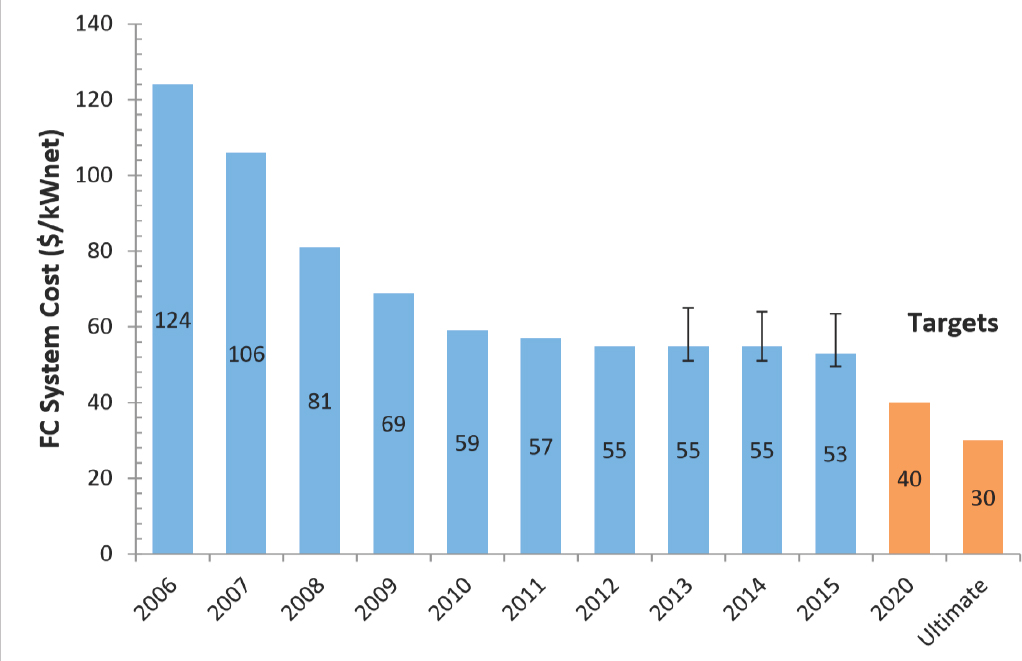
SOURCE: DOE (2015a).
___________________
9 See https://energy.gov/eere/budget/past-and-present-eere-budget (accessed December 1, 2019).
fuel cell systems that are based on current technology is approximately $280/kW when manufactured at a volume of 20,000 units per year.) To enable commercially competitive fuel cell vehicles, DOE and its contractors are targeting a cost reduction to $40/kW by 2020. Long-term competitiveness with alternative powertrains is expected to require further cost reduction to $30/kW, which represents DOE’s ultimate cost target.
7.1.2.10 Commercial Vehicle Experience with Fuel Cells
Although there have been recent introductions of light-duty fuel cell electric vehicles for sale by Toyota, Honda, and Hyundai, significant challenges remain in the commercialization of medium- and heavy-duty fuel cell vehicles. As a point of reference, the California Air Resources Board initiated a Transit Agency Fleet Rule in 2000 which requires large transit agencies to purchase buses with zero exhaust emissions. This requirement was originally planned to begin in 2008, after a demonstration phase wherein the transit agencies purchased and operated qualifying buses. A second demonstration phase was later added to the plan.
The first phase of demonstrations involved seven hydrogen fuel cell buses across three transit agencies. The demonstration featured two fuel cell bus configurations: hydrogen fuel cell buses and hybrid hydrogen fuel cell buses. As reported by the National Renewable Energy Laboratory (NREL, 2015), in “Fuel Cell Buses in U.S. Transit Fleets: Current Status 2015,” after the initial demonstration projects, fuel cell buses were some 4.5 times as expensive, were only 15 percent as reliable, and cost $4.60 per mile more to operate than a natural gas bus, which is the de facto standard vehicle in the South Coast Air Basin where the demonstrations took place.
The initial demonstration fuel cell buses cost more than $3 million each (Gladstein, Neandross, and Associates, 2014, p. 10). The three hydrogen fuel cell buses did not contain energy storage, demonstrated fuel economy worse than diesel buses, and exhibited miles between road calls (MBRC) which were only 10 percent of the diesel buses (Gladstein, Neandross, and Associates, 2014, p. 10). Three hybrid fuel cell buses showed significantly better fuel economy—almost 70 percent better—than their diesel counterparts. However, the diesel buses do not have energy storage and regenerative braking, so the benefit associated with the fuel cell technology alone cannot be stated. Unfortunately, these buses also demonstrated poor reliability, with just over 10 percent of the diesel MBRC. One hybrid fuel cell bus had the best fuel economy of the demonstrations; however, it achieved only 2,200 MBRC, compared to 14,000 MBRC for diesel buses (Gladstein, Neandross, and Associates, 2014, p. 10). These operational and cost issues caused a delay in the purchase schedule while the second advanced demonstration was implemented.
The second demonstration included 12 additional hydrogen fuel cell vehicles introduced in between 2009 and 2011 and is being conducted through a joint partnership of five Bay Area transit agencies. A June 2014 report, “Equivalent Strategies for the ARB Zero Emission Bus Regulation” (Gladstein, Neandross, and Associates, 2014), presents the updated results of the second round of advanced demonstration projects and summarizes the results found by NREL in its 2013 summary of hydrogen fuel cell electric buses. The cost of the second-phase hybrid hydrogen fuel cell buses remained high at over $2.2 million each (Gladstein, Neandross, and Associates, 2014, p. 10) compared to just over $450,000 for a natural gas bus. However, performance improvements were demonstrated in the second phase. After one year of the second phase, the fuel cell buses were shown to be some 50 percent as reliable and cost about $3.41 per mile more to operate than a natural gas bus. The report by NREL (2015) provides the latest update. There are 11 active fuel cell electric bus demonstration programs currently ongoing within the United States, which includes some 24 total buses deployed (Table 7-1).
NREL began collecting data on two more projects in 2014: a Proterra fuel cell electric bus (FCEB) in operation at Capital Metro in Austin, Texas, and an EV America FCEB in operation at Birmingham-Jefferson County Transit Authority in Birmingham, Alabama. Both these FCEBs have battery-dominant fuel cell propulsion systems. The status of FCEBs relative to DOE targets is summarized in Table 7-2.
However, NREL finds these systems to not yet be ready for commercialization, and considers them on a Technology Readiness Level (TRL) 7.
TABLE 7-1 U.S. Fuel Cell Bus Demonstrations in Calendar Year 2015
| Bus Operator | Location | Total Buses | Active Busesa | Technology Description | |
|---|---|---|---|---|---|
| 1 | AC Transit, Zero Emission Bay Area,b | San Francisco Bay Area, CA | 13 | 12 | Van Hool bus and hybrid system integration, US Hybrid fuel cell |
| 2 | SunLine Transit Agency, AT FCEBb | Thousand Palms, CA | 1 | 1 | New Flyer bus with Bluways hybrid system and Ballard fuel cell |
| 3 | SunLine Transit Agency, American Fuel Cell Bus (AFCB) (prototype)b | Thousand Palms, CA | 1 | 1 | ElDorado/BAE Systems/Ballard next-generation advanced design to meet “Buy America” requirements |
| 4 | SunLine Transit Agency, AFCB | Thousand Palms, CA | 3 | 3 | ElDorado/BAE Systems/Ballard updated AFCB design |
| 5 | Birmingham-Jefferson County Transit Authorityb | Birmingham, AL | 1 | 1 | EVAmerica bus with Embedded Power hybrid system and Ballard fuel cell |
| 6 | Capital Metrob | Austin, TX | 1 | 1 | Proterra composite body with a next-generation battery-dominant hybrid system and a Hydrogenics fuel cell |
| 7 | University of California at Irvine | Irvine, CA | 1 | 1 | ElDorado/BAE Systems/Ballard updated AFCB design |
| 8 | Flint MTA, Nutmegb | Flint, MI | 1 | 1 | Van Hool bus and hybrid system integration, US Hybrid fuel cell |
| 9 | Flint MTA, AFCB | Flint, MI | 1 | 1 | ElDorado/BAE Systems/Ballard updated AFCB design |
| 10 | University of Delaware (Phase I and 2) | Newark, DE | 2 | 1 | Ebus battery-dominant plug-in hybrid using Ballard fuel cells (22 ft) |
| 11 | Greater New Haven Transit District | New Haven, CT | 1 | 1 | Ebus battery-dominant plug-in hybrid using Ballard fuel cells (22 ft) |
| Total | 26 | 24 |
aTotal buses in actual service as of August 2015.
bProject received funding through the Federal Transit Administration’s National Fuel Cell Bus Program.
SOURCE: NREL (2015).
7.1.2.11 Nikola Hydrogen Fuel Cell Class 8 Tractor and Day Cab
In December 2016, Nikola Motor Company announced the introduction of a hydrogen fuel cell–powered Class 8 tractor which charges a 320 kWh battery pack for over-the-road service (see Table 7-3 for more technical specifications). According to the company, the battery pack is comprised of some 32,000 individual lithium-ion cells. By comparison, a 2015 Tesla Model S with an 85 kWh battery utilizes over 7,000 individual cells (see Chapter 8).
The Nikola 1 subsystems are described in Box 7-1. A fixed production date has not been announced at the time of this writing. However, deposits have been taken for future production vehicles.10 Nikola Motor Company has also announced plans for a Class 8 day-cab version for urban use.
___________________
10 Nikola Motor Company, December 1, 2016, “Nikola One Truck Revealed Tonight @ 7:00 p.m. MST,” https://dxtn4vayafzin.cloudfront.net/nikolamotor/uploads/press_release/pdf/8/December_1_Release.pdf (accessed March 21, 2017).
At the time of this writing, pricing for the Nikola One Class 8 tractor is identified as a lease plan which includes hydrogen fuel. Due to limited hydrogen fueling infrastructure in the United States, the extent of potential market penetration remains to be seen. However, the concept of a fuel cell power source coupled to a large battery pack represents a very expensive combination, such that significant cost reduction would be necessary for such a solution to become commercially viable.
7.1.2.12 Hydraulic Hybrid Powertrain Vehicles
Due to the level of power which is potentially required to brake or propel a medium- or heavy-duty hybrid vehicle, the size, cost, and weight associated with batteries, battery packs, electric motors, and other related equipment can become challenging. Especially for duty cycles in which there are a significant number of braking and subsequent acceleration events, hydraulic hybrid powertrain systems have demonstrated high regenerative braking efficiencies (>70 percent),11 at high power (100 to 200 kW or greater).
In a hydraulic hybrid powertrain vehicle (HHV), the energy storage device is a hydraulic accumulator, which uses high-pressure hydraulic fluid to move a piston or expanding elastomeric bladder to compress a gas, normally nitrogen. Unlike batteries, there is no need for electrochemical energy transfer, such that very high power levels can be achieved with high in/out energy storage efficiency. Hydraulic pumps/motors replace electric generators/motors in the HHV system and are very compact for the level of power which can be generated. Operating pressures for such systems are normally around 5,000 pounds per square inch (psi) (340 bar) although work is ongoing to increase the operating pressures to reduce the size of the high-pressure accumulators. There is also a low-pressure reservoir that stores hydraulic fluid after it passes through the hydraulic motor piston assembly and transfers the high potential energy of the fluid into torque and power across the motor to drive the wheels. During regenerative braking, a hydraulic pump, or the same pump/motor system acting as a pump, pressurizes the system, which in turn compresses the gas in the high-pressure accumulator.
___________________
11 U.S. Environmental Protection Agency, “Hydraulic Hybrid Vehicles,” https://www.epa.gov/cati/hydraulic-hybrid-vehicles (accessed May 18, 2017).
TABLE 7-2 Comparison of Fuel Cell Electric Bus Performance with U.S. DOE Targets
| Units | Current Statusa (Range) | 2016 Target | Ultimate Target | |
|---|---|---|---|---|
| Bus lifetime | years/miles | 0.25-4.9/7,900-117,000b | 12/500,000 | 12/500,000 |
| Power plant lifetimec | hours | 660-20,000b,d,e | 18,000 | 25,000 |
| Bus availability | % | 40-92 | 85 | 90 |
| Fuel fillsf | per day | 1 | 1 (<10 min) | 1 (<10 min) |
| Bus costg | $ | 2,100,000-2,400,000 | 1,000,000 | 600,000 |
| Road call frequency (bus/fuel cell system) | miles between road calls | 1,800-6,800/9,000-104,000 | 3,500/15,000 | 4,000/20,000 |
| Operation time | hours per day/days per week | 7-21/5-7 | 20/7 | 20/7 |
| Scheduled and unscheduled maintenance costh | $/mile | 0.54-1.33 | 0.75 | 0.40 |
| Range | miles | 240-340i | 300 | 300 |
| Fuel economy | miles per diesel gallon equivalent | 5.56-7.71 | 8 | 8 |
aThe summary of results in this report represents a snapshot from the included demonstrations: data from August 2014 to July 2015.
bAccumulated totals for existing fleet through July 2015; these buses have not reached end of life.
cFor the DOE/Federal Transit Administration targets, the power plant is defined as the fuel cell system and the battery system. The fuel cell system includes supporting subsystems such as the air, fuel, coolant, and control subsystems. Power electronics, electric drive, and hydrogen storage tanks are excluded.
dThe status for power plant hours is for the fuel cell system only; battery lifetime hours were not available.
eThe highest-hour power plant was transferred from an older-generation bus that had accumulated more than 6,000 hours prior to transfer.
fMultiple sequential fuel fills should be possible without an increase in fill time.
gCost targets are projected to a production volume of 400 systems per year. This production volume is assumed for analysis purposes only and does not represent an anticipated level of sales.
hExcludes mid-life overhaul of power plant.
iBased on fuel economy and 95 percent tank capacity.
SOURCE: NREL (2015).
TABLE 7-3 Additional Specifications Reported for Nikola One
| Motor type | 800V AC motors |
|---|---|
| Battery capacity and chemistry | 320 kWh lithium ion |
| Transmission | Two-speed automated with direct drive and low-noise gears |
| Drive system type | 6×4 four-wheel drive |
| Active descent control | Regenerative braking |
| Cooling | Biodegradable non-electrically conductive liquid coolant |
SOURCE: Nikola Motor Company.
Figure 7-10 shows the layout of a series HHV where, in common with a series HEV, the hydraulic pump is driven by the engine, which either charges the high-pressure accumulator or drives the hydraulic pump/motor operating in motor mode to drive the wheels.
During a regenerative braking event, the hydraulic pump/motor switches into pump mode and recharges the high-pressure accumulator. Additional braking is required once the accumulator is fully charged; just as in an HEV, the friction brakes are used to stop the vehicle. However, due to the high amount of braking energy that is absorbed by the hydraulic system, due to its high efficiency (typically >70 percent), significant maintenance cost savings can be realized by reducing the friction brake replacement frequency by a factor of 2 to 4. The low-pressure reservoir completes the hydraulic circuit, either charging the hydraulic pump during the engine power transfer mode, accepting the low-pressure discharge from the drive motor which is connected to the wheels, or charging the pump/motor acting as a pump during regenerative braking.
A hydraulic pump/motor/accumulator system can transfer high power with high efficiency in a short period of time. Battery systems, on the other hand, tend to require increasingly large batteries in order to transfer sufficient power generated during medium- and heavy-duty vehicle events, due to the large mass of such vehicles and the power needed to brake or accelerate them. However, the specific energy (amount of energy stored per unit of volume or mass [weight]) is relatively low for hydraulic propulsion systems, compared to batteries. Therefore, the time during which a medium- or heavy-duty HHV can be driven by the accumulator system is relatively short, typically not much longer than an acceleration from stop to 40 to 60 mph.
HHVs can also be configured as a parallel system. In such a layout, the size of the high-pressure accumulator is typically limited to store the energy of a single regenerative braking cycle. As such, this parallel system is also sometimes called a “launch assist” configuration. Figure 7-11 shows the layout of a typical parallel HHV system. Parallel HHVs are typically used for applications where there is a significant amount of operation under repeated braking and acceleration cycles, combined with a reasonable portion of the duty cycle that is related to normal on-highway use. Refuse trucks that require significant highway driving to reach their intended route, followed by a long distance to the disposal site, exemplify such an application.
The decision to use a series or parallel HHV for particular applications is primarily influenced by the efficiency of the propulsion system while driving on the highway. The regenerative braking and launch assist efficiency of series or parallel systems can be very similar (>70 percent). However, while operating under extended periods of highway driving, a series hybrid will cycle the engine on and off quite frequently due to the relatively low-energy storage capability of the accumulator (specific energy). In theory, the engine can operate at its peak efficiency (load and speed point) as it cycles on and off, thereby minimizing fuel consumption. On the other hand, in a parallel system, the engine can drive the wheels through a mechanical transmission with gear-drive efficiencies greater than 90 percent. Therefore, during on-highway operation, there is a trade-off between the frequently cycling series system and the continuous high-efficiency-transmission parallel system which may be driven by an engine whose operating points will be below its optimum efficiency curve. As in all medium- and heavy-duty hybrid vehicles,
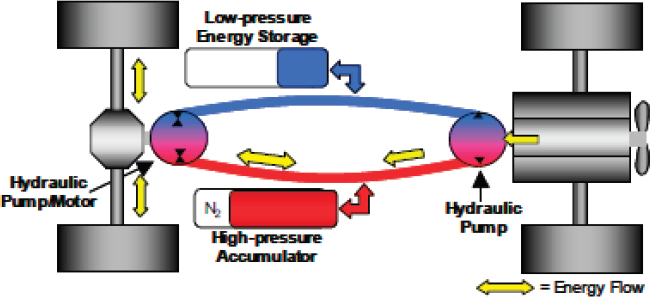
SOURCE: NRC (2010a).
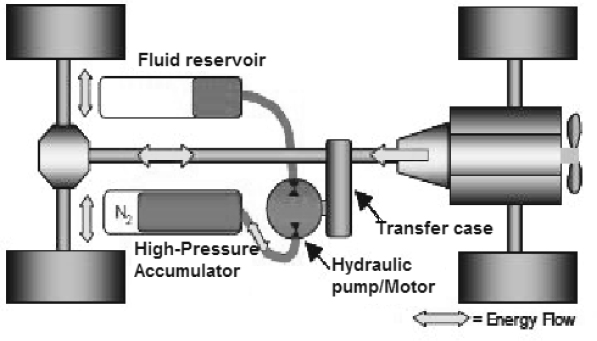
SOURCE: NRC (2010a).
the operational duty cycle is extremely important in determining the benefits which may be derived in real-world use and therefore commercial purchase decisions.
Currently, there are at least three HHV systems offered for commercial vehicles. Parker Hannifin has offered its “RunWise” system, which is installed in refuse truck applications. According to Parker12 there are some 200 refuse trucks currently using the RunWise system in commercial service and Parker claims up to 47 percent reduction in fuel consumption for refuse truck applications with a very high level of acceleration and braking cycles during normal use. This type of service, similar to city bus operating cycles, represents perhaps the best use of HHV technology because of the high efficiency of hydraulic systems during high power transfer for relative short periods of time during acceleration and subsequent braking to a stop. This allows the size of the high-pressure accumulator to be limited to the energy necessary for a braking cycle with subsequent high load acceleration.
The RunWise system represents a series hybrid drive system that incorporates a three-speed power drive unit that allows the engine to operate at peak efficiency. According to Parker, the “drive system is work brake compatible, has integrated traction control and end-user diagnostic capability” and “integrates with the existing ABS system and has a single point electrical interface to the chassis.”13 Parker is also introducing a hydraulic power-split transmission with regenerative braking and launch assist for application in vehicles ranging from delivery vans to transit buses (Parker Hannifin Corporation, 2012). According to Parker, depending on the speed range of the engine, a reduction gear assembly can be incorporated to maintain a maximum transmission speed of 2,600 rpm. A two-speed gearbox on the input shaft is offered as an option to allow additional initial torque for improved launch performance.
A second system applied to commercial vehicles, in this example refuse trucks, is offered by Stored Energy Solutions, Inc. (SES).14 This system is a parallel, mechanical-hydraulic break energy recovery and launch assist system that is installed together with the production refuse truck transmission. Unlike the Parker RunWise system, which replaces the production vehicle transmission, the SES system essentially reduces the launch and drive torque on the driveshaft of the truck, thereby reducing fuel consumption and lowering GHG emissions. There may also be benefits in reducing NOx and particulate emissions due to lower transient torques during vehicle acceleration. According to an Association for the Work Truck Industry publication,15 the SES system demonstrated a 16.3 percent
___________________
12 Parker Hannifin, September 21, 2015, “Parker Hannifin Hydraulic Transmission Outperforms Proposed EPA Emissions Regulations for Heavy-duty Trucks: RunWise® hydraulic technology reduces fuel consumption by an average of 43 percent,” http://www.parker.com/portal/site/PARKER/menuitem.31c35c58f54e63cb97b11b10237ad1ca/?vgnextoid=c0edc90375584510VgnVCM100000e6651dacRCRD&vgnextchannel=9104fbdc71fd7310VgnVCM100000200c1dacRCRD&vgnextfmt=EN&newsroom=Y&vgnextcat=News Release Details (accessed May 18, 2017).
13 Parker Hannifin, “Runwise Advanced Series,” http://ph.parker.com/us/en/runwise-advanced-series (accessed May 18, 2017).
14 Further information is available at http://ses-hydraulichybrid.com/intellidrive-2/.
15 NTEA Work Truck Show, February 2016.
reduction in fuel consumption (with a corresponding 21 percent improvement in fuel economy) while participating in a refuse truck demonstration in the City of Indianapolis, Indiana. As is true with all hybrid systems, the results were shown to be highly cycle dependent, with the system demonstrating a 32 percent improvement in fuel economy on one of the daily test routes.
A third HHV system that is applied to Class 3 through 5 vehicles is offered by Lightning Hybrids. This system is also a regenerative braking, subsequent launch assist, hydraulic hybrid system, a rendering of which is shown in Figure 7-12. Lightning Hybrids reports fuel consumption reductions on the order of 15 to 20 percent for stop- and-go bus-cycle testing, which translates into some 20 to 25 percent improvement in fuel economy.16 Lightning Hybrids on its website identifies real-world fuel economy improvements on the order of 20 to 30 percent.
The fuel consumption and associated GHG reductions with such parallel hydraulic launch assist systems all appear to be in the 15 to 25 percent reduction in fuel consumption performance region. As the level of technology increases, to include power-split or advanced parallel-series systems, such as the Parker RunWise system, improvements in fuel consumption are seen to achieve levels of 35 to 40 percent, in addition to reduced criteria pollutants such as NOx and CO, and significant improvements in brake system life, due to greatly reduced loads on the foundation brakes on commercial vehicles fitted with regenerative braking.
7.1.2.13 Full Series Hydraulic Hybrids
For a period of about 15 years, ending in 2013, EPA supported a major research and development effort to demonstrate the fuel consumption reduction and GHG emission benefits that could be gained by a true series hydraulic hybrid system. Demonstration programs conducted with prototype delivery vans17 and 30-person buses demonstrated improvements in fuel economy that exceeded 100 percent, or doubling of the fuel economy, which represents over a 50 percent reduction in fuel consumption (EPA, 2016).
The system was a series configuration, with a pump/motor which drives the wheels through a three-speed transmission which receives high-pressure hydraulic fluid from the high-pressure accumulator, or from the high-pressure hydraulic pump that is connected to the combustion engine. High efficiency is achieved by careful matching of the variable displacement traction motor to the required operational characteristics of the vehicle. This hydraulic motor also acts as a high-efficiency pump during regenerative braking cycles, replenishing the high-pressure fluid in the high-pressure accumulator.
As the system is of the series design, a variable displacement pump is driven by the engine in the vehicle, which allows the engine to operate near its optimum efficiency point while it is running, to provide high-pressure hydraulic fluid to drive the traction motor, recharge the accumulator, or both. The engine shuts down during regenerative braking, when the traction pump motor recharges the high-pressure accumulator. During a subsequent launch the stored higher-pressure fluid in the accumulator flows through the traction motor, driving the vehicles. When the quantity of high-pressure fluid is depleted, the engine starts, then runs near optimum efficiency while driving the high-pressure supply pump. This particular series hydraulic hybrid technology, developed under EPA funding, is still in the developmental stage and has not yet been released for series production (Kargul et al., 2015).
7.1.2.14 Hydraulic Hybrid System Costs
In the case of a series/parallel type of system, similar to that currently offered by Parker Hannifin, the anticipated net price (after some credit for replacing the normal transmission) of the total hybrid system is estimated to be on the order of $45,000 to $55,000 in production volumes up to about 10,000 units per year. Such a system includes a high-pressure accumulator and associated control valves, high-pressure hydraulic lines, two high-pressure hydraulic pumps/motors, a low-pressure reservoir system, a two- or three-speed gearbox, electronic controls, and in some cases expanded use of a hydraulically actuated accessory drive in order to operate a power steering pump and air conditioner compressor while the engine is off. In some extremely high-frequency stop-start operating
___________________
16 “Lightning Hybrids: The Solution,” https://www.nrel.gov/workingwithus/assets/pdfs/2015-igf-lightning-hybrids.pdf (accessed May 18, 2017).
17 EPA, “Hydraulic Hybrid Vehicles,” https://www.epa.gov/cati/hydraulic-hybrid-vehicles (accessed May 18, 2017).
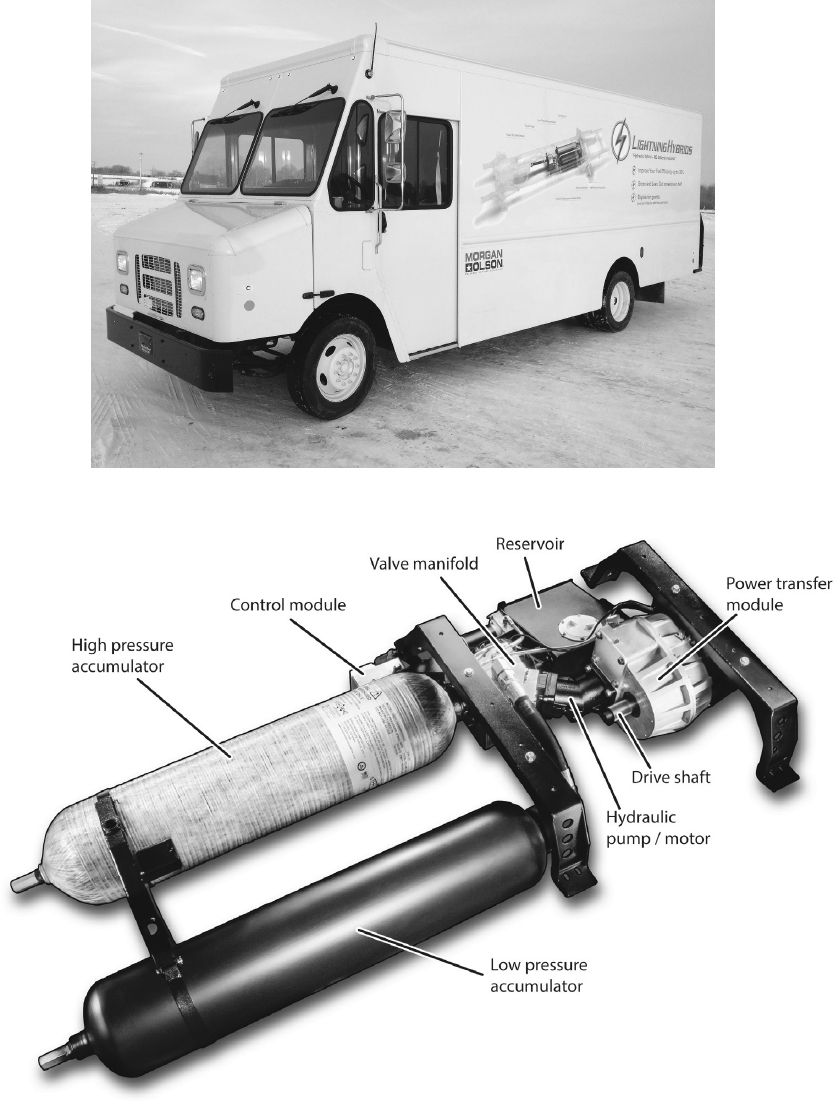
SOURCE: Image used by permission of Lightning Hybrids, LLC.
cycles, there may be several minutes between operating periods of the engine. Higher production volumes could result in somewhat lower costs, but even at 40,000 units per year, the price for such systems would likely be in the range of $35,000 to $37,500 per system.
However, a hydraulic power-split transmission with integrated regenerative energy recovery and launch assist, would likely have a retail price of $25,000 to $30,000 per unit in production volumes under 10,000 units per year, but could see greater cost reductions with higher volumes, on the order of 40,000 to 50,000 units per year. At such production volumes, the committee estimates the retail price for these regenerative braking, power-split transmission systems would approach $15,000 to $20,000 per unit.
The cost of a parallel system like that of SES, where the traditional transmission is retained but parallel drive and brake energy recovery are accomplished via a mechanical PTO which is included in the existing transmission or through an auxiliary drive in-line with the driveshaft, is estimated to have a retail price of approximately $15,000 to $20,000, again in production volumes on the order of 10,000 units per year. Higher volumes (40,000 units per year) could lower these prices to about $12,500 to $15,000 per unit.
7.2 DIFFERENCES BETWEEN LIGHT-DUTY AND HEAVY-DUTY HYBRIDS
Due to the nature of their intended personal use, light-duty vehicles tend to operate under relatively low load conditions, except during acceleration, trailer towing conditions, or other heavier load cycles. This is not necessarily true for certain light-duty trucks, vans, and SUVs which are used in commercial or industrial applications. However, across the normal passenger car and light-duty truck, the clear majority of vehicles are driven for personal use.
Since the mid-1970s there have been regulatory and other efforts aimed at reducing criteria pollutants and emissions that adversely affect local air quality (NRC, 2010b). Over the past decade, there has been very significant investment across almost all passenger car and light-duty truck manufacturers, as evidenced by new product offerings (see Table 8-1), to employ varying levels of electric hybridization, to reduce the smog-forming emissions, but also in response to the most recent light-duty vehicle Corporate Average Fuel Economy and GHG emissions.
A recent NRC study, Cost, Effectiveness, and Deployment of Fuel Economy Technologies for Light-Duty Vehicles (NRC, 2015), provides a very thorough explanation of the current state of electrification in light-duty vehicles, their functional benefits, their current product offerings, and current associated costs and projections for future potential (both cost and performance). The report provides a very good history and summary of hybrid and battery electric vehicles in the light-duty space. In addition to a very detailed technical discussion, which shows the similarities to the systems identified in the early part of this chapter, the report summarizes product offerings by different levels of electrification, culminating in battery electric vehicles. The report also provides a very good summary of the relative improvements in fuel consumption and associated reductions in GHG emissions through the implementation of the various types of product offerings.
Although the general types of hybrid technology that have been developed for light-duty vehicles can, in principle, be applied to medium- and heavy-duty vehicles, the overall size and weights of commercial vehicles, combined with the significantly different operating cycles, makes the application of light-duty hybrid technology much more difficult to employ, challenging to meet commercial vehicle lifetimes, and sometimes difficult to achieve cost effectiveness.
7.3 MAPPING TECHNOLOGIES TO DUTY CYCLES
The fuel consumption and CO2 benefits that can be derived from the use of HEVs are highly dependent on the type of vehicle, its size and weight, and, most importantly, its intended duty cycle. Use cases involving a high frequency of braking cycles, such as refuse trucks or urban buses, can gain significant benefits through regenerative braking, where the size of the energy storage system can be somewhat limited in size to recover primarily only the braking energy and then launch the vehicle.
Other applications, such as urban delivery trucks, may choose to incorporate larger energy storage systems and optimize total route operational efficiency with a combination of regenerative braking and periods of operating the ICE and higher load levels, to minimize carbon-based fuel consumption.
The NRC Phase One Report, Technologies and Approaches to Reducing the Fuel Consumption of Medium- and Heavy-Duty Vehicles (NRC, 2010a), provides a detailed explanation of the operational cycles to be considered and the relative fuel consumption and GHG benefits that may be derived.
Table 7-4 is presented below to list the relative benefits in application of hybrid technology for different classes of vehicles and the type of duty cycle they typically perform. The table shows a range of hybridization including simple 12-volt stop-start; a higher voltage (48 V) integrated starter/generator mild hybrid with launch/regeneration capability; and a high voltage (>200 V) strong hybrid with limited all-electric operation. The costs associated with these systems are shown in Table 7-6 below and the cost effectiveness for different use cases is summarized in Chapter 12.
7.4 CURRENT MANUFACTURERS AND PRODUCT RANGES
A summary of several commercially available hybrid commercial vehicles (both electric and hydraulic) available at the time of this writing is included in Table 7-5. Attempting to spur early market introduction of a technology that would otherwise not be cost effective for the purchaser, various federal, state, and local financial incentives are available to subsidize the cost of many hybrid vehicle and powertrain system suppliers. Especially in the case of transit buses, these subsidies can be significant. Within the 2030 time frame of this report focus,
TABLE 7-4 Relative Fuel Consumption Benefits of Electric Hybrid Components by Class
| Vehicle Class | Hybrid Type | Vehicle Use | Duty Cycle | Approx. FC Reduction (%) |
|---|---|---|---|---|
| Class 2b-3 | 12 V start/stop (S/S) belt-starter-generator (BSG) | Heavy-duty pickup and van | Urban + highway | 3.5 |
| Class 2b-3 | Integrated S/S with regen/launch assist | Heavy-duty pickup and van | Urban + highway | 10 |
| Class 2b-3 | Parallel strong hybrid | Heavy-duty pickup and van | Urban + highway | 20 |
| Class 4-5 | 12 V S/S BSG | Vocational vehicles | Urban + highway | 3.5 |
| Class 4-5 | Integrated S/S with regen/launch assist | Vocational vehicles | Urban + highway | 16 |
| Class 4-5 | Parallel strong hybrid | Vocational vehicles | Urban + highway | 20 |
| Class 4-5 | 12 V S/S BSG | Delivery trucks | Urban delivery | 3.5 |
| Class 4-5 | Integrated S/S with regen/launch assist | Delivery trucks | Urban delivery | 20 |
| Class 4-5 | Parallel strong hybrid | Delivery trucks | Urban delivery | 25 |
| Class 6-7 | 12 V S/S BSG | Vocational vehicles | Urban + highway | 3.5 |
| Class 6-7 | Integrated S/S with regen/launch assist | Vocational vehicles | Urban + highway | 16 |
| Class 6-7 | Parallel strong hybrid | Vocational vehicles | Urban + highway | 20 |
| Class 6-7 | 12 V S/S BSG | Delivery trucks | Urban delivery | 3.5 |
| Class 6-7 | Integrated S/S with regen/launch assist | Delivery trucks | Urban delivery | 20 |
| Class 6-7 | Parallel strong hybrid | Delivery trucks | Urban delivery | 25 |
| Class 8 | 12 V S/S BSG | Vocational refuse truck | Urban accel/brake | 3.5 |
| Class 8 | Integrated S/S with regen/launch assist | Vocational refuse truck | Urban accel/brake | 22 |
| Class 8 | Parallel strong hybrid | Vocational refuse truck | Urban accel/brake | 30 |
TABLE 7-5 Hybrid Commercial Vehicles Currently Available (2017)
| Manufacturer | Product Example | Application |
|---|---|---|
| Hino | Class 5 cab-over electric hybrid | Delivery Trucks |
| Allison | Heavy heavy-duty (HHD) parallel hybrid | Transit Bus |
| BAE | HHD series or parallel hybrid | Transit Bus |
| XL | Class 3-4 mild electric hybrid | Shuttle Bus |
| Crosspoint Kinetics | Class 3-7 mild electric hybrid | Delivery trucks, shuttle buses |
| Lightning Hybrids | Class 2-5 hydraulic hybrid | Delivery trucks |
| Parker Hannifin | Medium heavy-duty hydraulic hybrid | Delivery trucks |
| Freightliner Custom Chassis | MHD hydraulic hybrid | Delivery trucks |
| Morgan Olson | MHD hydraulic hybrid | Delivery trucks |
| Autocar-Parker | RunWise hydraulic hybrid | Refuse trucks |
| Eaton (1) China Application | HHD parallel electric hybrid | Trucks and buses |
| Odyne | Plug-in electric hybrid, E-PTO | Utility trucks |
| Efficient Drivetrains Inc. | Plug-in electric hybrid, E-PTO | Utility trucks |
such subsidies may or may not exist. Therefore, in the cost analyses presented in the following chapter, the cost benefit is evaluated without subsidy.
7.5 ADVANCES IN TECHNOLOGY AND COST REDUCTION OF ELECTRIC MOTORS AND POWER ELECTRONICS FOR HYBRID AND BATTERY ELECTRIC VEHICLES
As identified in the preceeding sections of this chapter, significant progress has been made in the reduction of battery cell and pack costs for use in light-duty hybrid and battery electric vehicles. A rather detailed discussion on battery technology and projected improvements is included in Chapter 8.
While many years of research and development by the automotive industry, battery suppliers, and governmental research laboratories has yielded significant battery advancements, similar efforts on the rest of the electrified powertrain components have been somewhat later in developing. However, it appears that much more attention is now being placed on these non-battery electrified powertrain systems, especially within the EERE of DOE (Rogers and Boyd, 2016).
As shown in Figure 7-13 below, the remaining parts of the electrified powertrain include the electric motor (which may also function as a generator during regenerative braking), the power inverter(s), any on-board battery charger(s), and voltage converter(s). The complete system also includes low-voltage wiring, high-voltage cables, cooling circuits (including pumps), electrical disconnect circuits, and various microprocessor control modules.
The Electric Drive Technologies (EDT) program is a joint research and development program which includes the DOE, various national laboratories, vehicle original equipment manufacturers (OEMs), Tier 1 suppliers, and various other tiered suppliers, other government agencies, universities, and research organizations. Much like the U.S. Automotive Battery Consortium (USABC), specific size, weight, specific energy, and cost targets are established and monitored annually in program merit reviews.
The stated goal of the EDT program is to approach similar cost and convenience targets for plug-in electric vehicles as their gasoline-fueled counterparts by the year 2022. To accomplish this aggressive goal, the electrified powertrain motors and power electronics would need to demonstrate a combined unit cost of $8/kW propulsion power, with a system efficiency of 94 percent, while achieving a specific energy of 1.4 kW/kg and an energy density of 4.0 kW/L (Rogers and Boyd, 2016). Figure 7-14 shows that to achieve these aggressive targets, compared to 2012 electrified drivetrain production systems, the cost will need to be reduced by a factor of 4, with a 35 percent reduction in size, 40 percent reduction of weight, and elimination of 40 percent of electrical, fluidic, and frictional losses in the system.
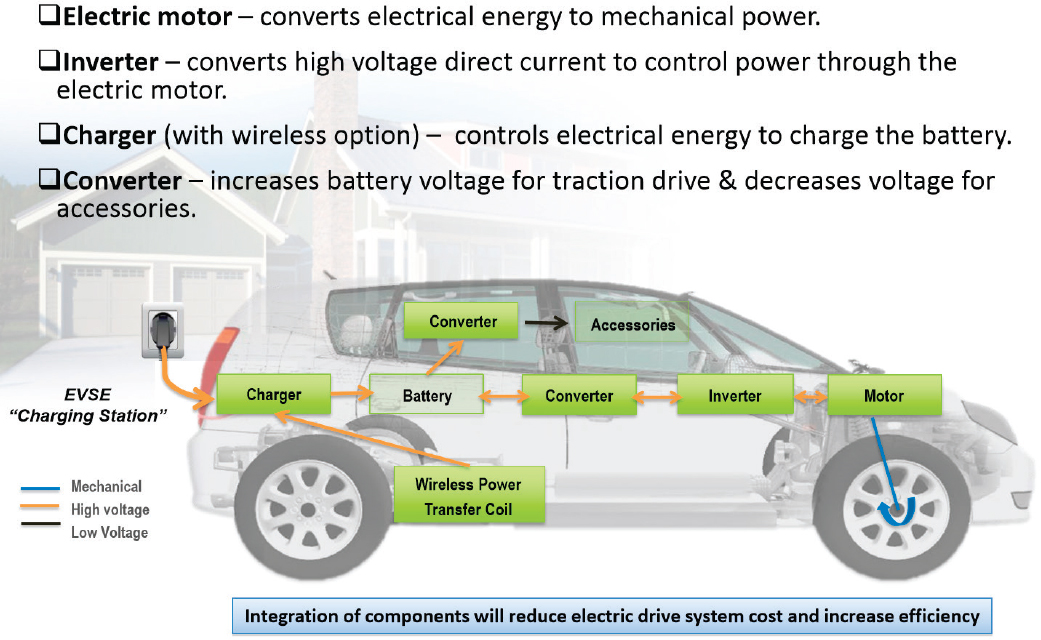
SOURCE: Rogers and Boyd (2016).
As a gauge for individual subsystem cost reduction challenges, the 2015 production costs for the electric traction motors and power electronics for a typical passenger car (3,500 to 4,000 pounds vehicle weight) are approximately $7/kW and $5/kW, respectively, for a total combined cost of $12/kW. In order to achieve the 2022 combined cost of $8/kW, Figure 7-15 shows that the power electronics cost must achieve about $3.30/kW and the traction motor must approach $4.70/kW (Rogers and Boyd, 2016).
The 2016 roadmap to achieve these aggressive cost reduction targets, which was developed in cooperation with OEMs and Tier 1 suppliers, is shown in Figure 7-16. The reduction in combined power electronics and traction motor cost, from about $30/kW in 2012 to $12/kW in 2015, was primarily accomplished by improvements in silicon-based power electronics and reduction in rare-earth-metal content in the permanent magnet motors typically used in electrified powertrains. However, to achieve the 2022 goal of $8/kW, a shift in technology application will be necessary.
As Figure 7-16 depicts, further improvements in power electronics cost, energy density, and specific energy will likely require the production development of wide-bandgap (WBG) systems. The benefits of WBG electronics, compared to silicon-based systems, are summarized below (Box 7-2), which originates in the DOE document on WBG electronics (DOE, 2015b).
Under the EDT program, General Motors is developing a next-generation inverter which, when scaled to its highest power configuration is expected to achieve the $3.30/kW cost target by 2022. According to General Motors, the highly consolidated design incorporates advanced, vertically integrated manufacturing processes. Under the high-power rating, the traction motor inverter is also projected to achieve the specific energy and energy density targets of 14.1 kW/kg and 13.4 kW/L, respectively. Figure 7-17 shows the inverter exterior configuration.
Another major effort and technical challenge is the reduction in cost of electric traction motors for use in hybrid and battery electric vehicles. As identified in Figure 7-18, a key to achieve the 2022 cost target of $4.70/
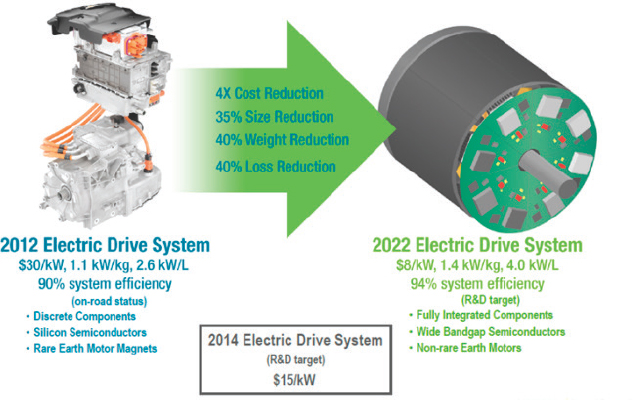
SOURCE: DOE (2015c).
kW is a very large reduction in, or elimination of, rare-earth material use in the motors. Under the EDT program, General Electric is developing next-generation high-performance motors with non–rare-earth materials (Rogers and Boyd, 2016).
The challenges to achieve the motor cost goals include
- High efficiency over wide speed and load ranges;
- High power density and high coolant inlet temperature;
- High speed, which poses mechanical challenges;
- Non–rare-earth permanent magnets; and
- Low-cost targets based on 100,000 units per year.
To achieve the high energy and power densities, the motors will need to operate at relatively high speeds, around 14,000 rpm. However, with high speed comes high frequencies, higher stresses, and higher stator core and rotor losses. The technical goals for this next generation of non–rare-earth motors are shown in Figure 7-18 (Rogers and Boyd, 2016).

SOURCE: Rogers and Boyd (2016).
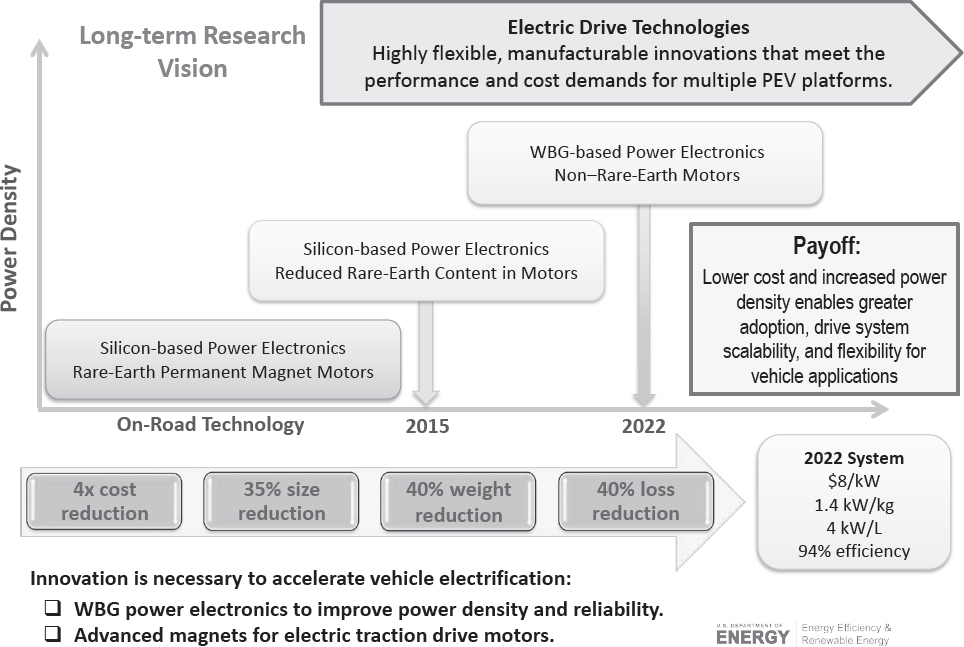
SOURCE: Rogers and Boyd (2016).
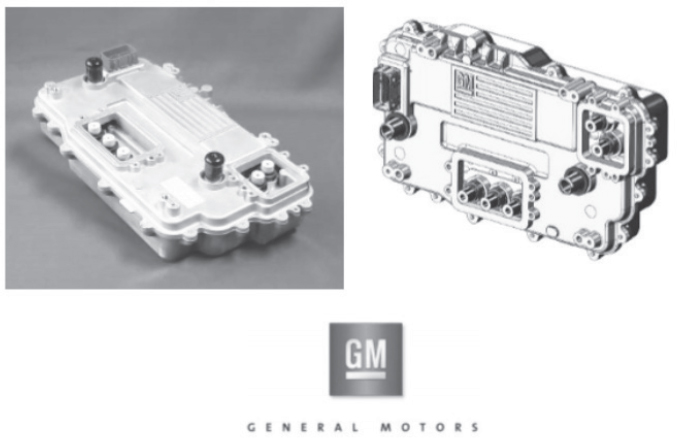
SOURCE: Rogers and Boyd (2016).
Although the overall power requirements for the use of electric motors in large passenger cars and light-duty trucks are similar to those in medium-duty and some heavy-duty vehicles (approximately 250 to 350 hp maximum), the torque requirements for commercial vehicles are significantly higher. However, the potential to generate high torque at low speeds from electric motors is excellent, as shown by the increasing torque with decreasing speed in Figure 7-18.
Accordingly, the design characteristics for medium- and heavy-duty truck electric motors will require larger diameter, higher weight, and lower speed ranges than those currently offered in light-duty vehicles. In some PHEV and BEV applications, the high-torque characteristics of electric motors can reduce the number of transmission gear ratios needed, or even eliminate the transmission completely for relatively low-vehicle-speed applications, such as intracity buses.
However, the current focus by DOE as shown above is for higher-speed-range motors for light-duty applications. Therefore, future R&D activities for commercial vehicle applications are likely needed to develop lower-cost solutions, including reducing or eliminating the use of rare-earth materials in the permanent magnets.
7.6 COST AND EFFECTIVENESS OF HYBRID AND ELECTRIC MEDIUM- AND HEAVY-DUTY VEHICLES
The manufacturing cost of hybrid and all-electric drive medium- and heavy-duty powertrains is dominated by the costs of the related battery packs, electric motors, power electronics, and associated cooling, wiring, and electronic controls systems. As discussed in Chapter 8, significant reduction in costs for battery cells and packs for light-duty vehicles has been achieved. Within this chapter, research and development efforts to achieve similar factors (fourfold) of reduction of motors, power electronics, and associated cooling and control systems are also presented.
Based on a review of industry and governmental research agency published literature—Regulatory Impact Analyses (RIAs) and Technical Assessment Reports by EPA and NHTSA—recent press announcements by automotive, light truck, and commercial vehicle manufacturers, and the professional experience of committee members, an estimate of future electrified powertrain costs has been prepared. The technical discussion presented within this chapter outlines a very broad range of technologies that could be applied for future hybrid and battery electric commercial vehicles. The committee has reduced the technology applications and range of vehicle classes to those
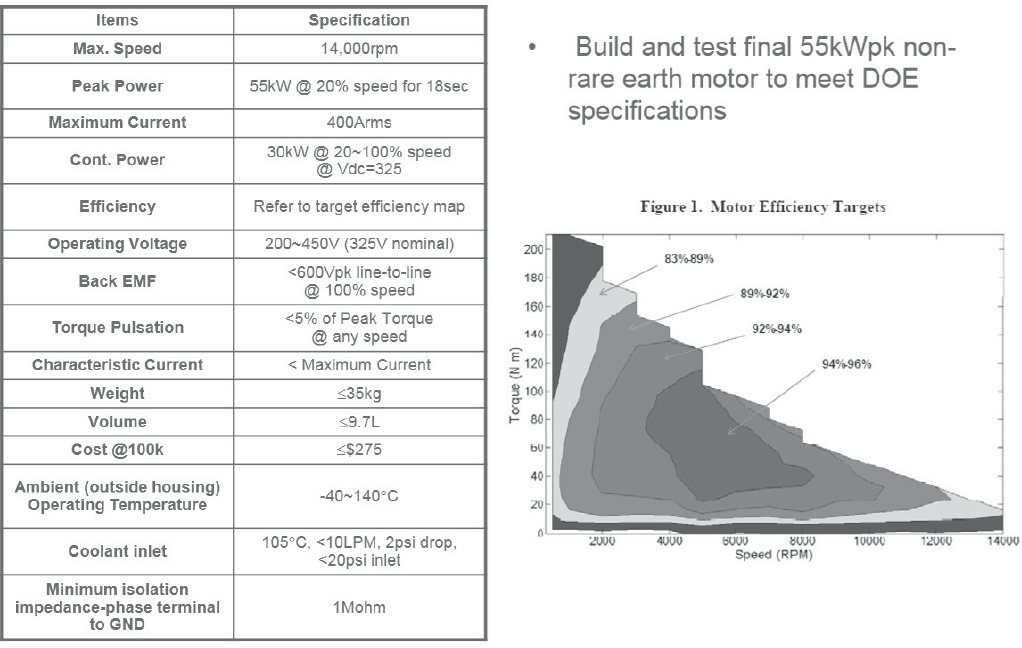
SOURCE: EL-Refaie (2016).
the committee believes have a reasonable probability of success, based on relative cost, vehicle class, potential duty cycle, and the potential for effective service and warranty support.
Table 7-6 presents a projected hybrid system distribution across Class 2b and 3 trucks and vans, Class 4 vocational vehicles and Class 4 delivery trucks, Class 5 vocational vehicles and Class 5 delivery trucks, Class 6 and 7 vocational vehicles and Class 6 and 7 delivery trucks, and Class 8 vocational vehicles (refuse trucks). The levels of hybridization range from stop-start systems (12 V) with no regeneration capability, to integrated stop-start (48 V) with limited launch assist and regenerative energy recovery, to fully integrated high-voltage hybrid systems with full tractive power to operate the vehicle for an extended time under electric power drive only.
The percent reduction in fuel consumption for each technology category is estimated based on relative duty cycle and is compared to a model year (MY) 2015 typical diesel-powered vehicle. The relative improvement from a reduction in energy storage is assumed to be the same for MY 2022 and MY 2030. The difference in cost reflects further development and increasing production quantities which may lead to reduced production cost.
The relative fuel consumption improvement values were derived from several sources including the first medium- and heavy-duty fuel economy report (NRC, 2010a), published results from the EPA and NHTSA RIAs, and the analyses conducted for the committee by Southwest Research Institute.
The intent of Table 7-6 is to show the relative improvements in fuel consumption which can be obtained through the application of hybridization in medium- and heavy-duty vehicles. It is important to note that the improvements, relative to typical MY 2015 diesel-powered vehicles, are dependent on the size of the vehicle, the type of hybridization, and the typical duty cycle under which the vehicles may be operated.
Due to the state of battery, power electronics, and electric motor technology, production costs for these vehicles will be higher than for light-duty vehicles. The committee has attempted to estimate the production costs for these major components as they would be applied to commercial vehicles, recognizing that initial production volumes
TABLE 7-6 Hybrid System Cost Estimates (High and Low Cases)
| Vehicle Class | Year or or % Reduction in FC | Light Heavy-Duty (LHD) | |||||||||
|---|---|---|---|---|---|---|---|---|---|---|---|
| Class 2b and 3 Van and Pickup | Class 4 Vocational Vehicles | Class 4 Delivery Trucks | Class 5 Vocational Vehicles | Class 5 Delivery Trucks | |||||||
| Technology | Low Cost | High Cost | Low Cost | High Cost | Low Cost | High Cost | Low Cost | High Cost | Low Cost | High Cost | |
| Non-hybrid | 2015 | $1,190 | $1,210 | $1,710 | $1,725 | $1,710 | $1,725 | $1,710 | $1,775 | $1,710 | $1,775 |
| Enhanced accessories | 2022 | $477 | $540 | $724 | $800 | $724 | $800 | $744 | $850 | $744 | $850 |
| 12 V stop-start | % Reduction in FC | 3.50% | 3.50% | 3.50% | 3.50% | 3.50% | 3.50% | 3.50% | 3.50% | 3.50% | 3.50% |
| 2030 | $422 | $481 | $650 | $719 | $650 | $719 | $670 | $739 | $670 | $739 | |
| RIA integrated | 2015 | $5,150 | $5,175 | $9,800 | $9,850 | $9,800 | $9,850 | $9,800 | $9,900 | $9,800 | $9,900 |
| Mild hybrid regen/launch | 2022 | $2,208 | $2,435 | $4,584 | $5,010 | $4,584 | $5,010 | $4,584 | $5,060 | $4,584 | $5,060 |
| With stop-start | % Reduction in FC | 10% | 10% | 16% | 16% | 22% | 22% | 16% | 16% | 22% | 22% |
| 2030 | $2,005 | $2,201 | $4,240 | $4,602 | $4,240 | $4,602 | $4,260 | $4,652 | $4,260 | $4,652 | |
| Parallel strong hybrid | 2015 | $12,250 | $12,350 | $17,100 | $17,300 | $17,100 | $17,300 | $17,100 | $17,500 | $17,100 | $17,500 |
| SHEV (18-22% pickup and van) | 2022 | $5,094 | $5,730 | $7,426 | $8,320 | $7,426 | $8,320 | $7,426 | $8,520 | $7,426 | $8,520 |
| Electric drive | %Reduction in FC | 20% | 20% | 20% | 20% | 25% | 25% | 20% | 20% | 25% | 25% |
| $4,640 | $5,178 | $6,785 | $7,562 | $6,785 | $7,562 | $6,785 | $7,762 | $6,785 | $7,762 | ||
| Vehicle Class | Year or % Gain | Medium Heavy-Duty (MHD) | Heavy Heavy-Duty (HHD) | |||||
|---|---|---|---|---|---|---|---|---|
| Class 6 and 7 Vocational Vehicles | Class 6and 7 Delivery Trucks | Class 8 Vocational Vehicles (Refuse) | Class 8 Tractor-Trailers | |||||
| Technology | Low Cost | High Cost | Low Cost | High Cost | Low Cost | High Cost | ||
| Non-hybrid | 2015 | $2,150 | $2,180 | $2,150 | $2,180 | $3,300 | $3,350 | |
| Enhanced accessories | 2022 | $891 | $1,000 | $891 | $1,000 | $1,389 | $1,565 | |
| 12 V stop-start | (% gain) | 3.50% | 3.50% | 3.50% | 3.50% | 3.50% | 3.50% | |
| 2030 | ||||||||
| RIA integrated | 2015 | $17,100 | $17,225 | $17,100 | $17,225 | $21,000 | $21,900 | |
| Mild hybrid regen/launch | 2022 | $7,850 | $8,625 | $7,850 | $8,625 | $10,080 | $11,700 | |
| With stop-start | (% gain) | 16% | 16% | 22% | 22% | 22% | 22% | |
| 2030 | ||||||||
| Parallel strong hybrid | 2015 | $22,000 | $22,250 | $22,000 | $22,250 | $34,500 | $35,000 | |
| SHEV (18-22% pickup&van) | 2022 | $10,020 | $11,100 | $10,020 | $11,100 | $14,780 | $16,500 | |
| Electric drive | (% gain) | 20% | 20% | 25% | 25% | 30% | 30% | |
| 2030 | ||||||||
will be low and costs will likely come down in the 2022 and 2030 time frames. Chapter 12 evaluates the cost effectiveness of these potential applications and their commercial payback periods.
Although there is significant development ongoing for current and future introduction of PHEVs and full BEVs for passenger cars and light trucks and sport-utility vehicles (SUVs), the committee believes that the market penetration for these technology concepts for medium- and heavy-duty trucks and commercial vehicles will be rather limited over the next 10 years. This is based on the unique duty cycle, commercial vehicle durability, rough service requirements, and large power transfer requirements which differ from light-duty applications and the challenging cost effectiveness (payback period for the higher cost incurred) due to rather low projected energy and fuel costs over the next decade. Lack of high-power charging infrastructure may also limit deployment and use of MHD BEVs, for those that would need to be charged outside of a fleet facility. A detailed discussion of this cost-effectiveness assessment is included in Chapter 12.
As can be seen in Table 7-6, significant reductions in total system cost are estimated, starting from published costs extracted from various sources for 2015, and then projected by the committee to 2022 and 2030. The table also provides low and high cost estimates based on uncertainty associated with achieving cost reduction targets and the challenges related to the transfer of technology developments from light-duty passenger vehicles to much larger commercial vehicles.
Due to the much higher vehicle weights for commercial vehicles compared to passenger cars, the relative size of battery packs, electric motors, power electronics, and the rest of the hybrid-related system is much larger. As a result, the total system costs, related by cost per kilowatt of power or the necessary kilowatt-hour levels, are much larger, as shown in the table.
Table 7-6 also shows the percentage improvement in fuel consumption which was estimated by the committee, based on the vehicle class and the intended service. For vocational vehicles used in job-site-type applications, the potential fuel consumption improvement is less than delivery truck–type of usage where a high percentage of use is braking and subsequent acceleration driving. Therefore, the cost effectiveness, or fuel savings cost versus system cost, is dependent on the predominant driving cycle of the vehicle.
As stated above, Table 7-6 does not show projections for PHEV or BEV versions of commercial vehicles because the cost-effectiveness assessment does not show likelihood of commercialization. However, regulatory developments in foreign markets or local financial incentives in certain U.S. cities or states could promote earlier commercialization than would otherwise occur. International regulations under consideration to outlaw combustion engine use in commercial vehicles used in highly populated cities could justify an alternative set of financial boundary conditions, which could cause increased introduction of PHEV and BEV vehicles in certain U.S. markets.
Table 8-8 is presented at the end of Chapter 8 to show the projected cost breakdown assumptions which the committee used to develop the estimated total hybrid system costs. The table shows that the committee believes that the future cost reduction projections will be very significant, but will not achieve the very low costs estimated from passenger car applications. As discussed earlier in this chapter, the unique requirements for commercial vehicles will not allow complete carryover from light-duty vehicles. The table also shows the breakdown by battery pack, traction motor, power electronics, and other components which make up the “rest of system.” The relative sizes of battery pack (in kilowatt-hours), traction motor (in kilowatts), and method of hybridization are broken down by vehicle class and low or high cost estimates, and are projected to 2022 and 2030.
7.7 FINDINGS
Finding: Due to significant progress in the reliability improvement and cost reduction of lithium-ion battery systems in light-duty vehicles, meaningful application of hybridization will occur in Class 2b through 6 vehicles over the next 10 to 15 years, especially in those with urban stop-and-go duty cycles.
Finding: Certain subsystems developed as part of complete hybrid systems may individually be applied to Class 8 vehicles for cost-effective benefits, for example, engine decoupled coasting, stop-start, electrification of accessories, and auxiliary power units.
Finding: Because the commercial vehicle industry is so cost driven, compressed natural gas technology was adopted in many urban and centralized fueling applications as a means to reduce criteria pollutants and fueling costs. As hybrid technology, especially full hybrid and plug-in hybrid, costs continue to decline, it will compete as the lowest-cost option for urban and centralized fleets.
Finding: Light-duty dedicated hybrid and electric vehicles are being designed and manufactured in normal plant cycles to maximize synergy in the overall vehicle system, such as the Chevrolet Volt and Bolt. Currently, medium- and heavy-duty hybrid vehicles are produced by “up-fitting” or converted by higher cost by low-volume producers. Future dedicated hybrid designs will result in additional cost savings.
Finding: As purchase costs, maintenance costs, and operating downtime are reduced, the business case for hybrid applications in vocational vehicles with significant job-site and stationary operations will increase and market penetration will be significant.
Finding: Current R&D activities being undertaken by DOE and its industry partners are focused on the cost reduction of electric motors/generators for use in light-duty hybrid and electric vehicles. Due to the much higher torque requirements for medium- and heavy-duty drivetrains, the technical approaches for light-duty electric motor cost reduction may not directly carry over to the commercial vehicle space.
Recommendation 7-1: NHTSA and EPA should coordinate with DOE, other government agencies (Department of Defense, Office of Naval Research, the Defense Advanced Research Projects Agency, etc.), and private industry to develop a strategy for electric motor cost reduction R&D that is applicable to the high torque requirements for medium- and heavy-duty vehicles.
7.8 REFERENCES
DOE (U.S. Department of Energy). 2015a. 2015 Annual Progress Report. Hydrogen and Fuel Cells Program. https://www.hydrogen.energy.gov/annual_progress15.html (accessed December 19, 2019).
DOE. 2015b. Wide Bandgap Power Electronics Technology Assessment. Available at https://energy.gov/sites/prod/files/2015/02/f19/QTR%20Ch8%20-%20Wide%20Bandgap%20TA%20Feb-13-2015.pdf (accessed May 18, 2017).
DOE. 2015c. Quadrennial Technology Review 2015: Chapter 8: Advancing Clean Transportation and Vehicle Systems and Technologies: Technology Assessments. Available at https://www.energy.gov/sites/prod/files/2016/01/f28/QTR2015-8E-Plug-in-Electric-Vehicles.pdf (accessed August 31, 2019).
EL-Refaie, A. 2016. “Alternative High-Performance Motors with Non-Rare Earth Materials.” Presentation for DOE Peer Review. June 7. Department of Energy, Washington, DC. Available at https://www.energy.gov/sites/prod/files/2016/06/f32/edt045_elrefaie_2016_o_web.pdf.
EPA (Environmental Protection Agency). 2016. “Demonstration Vehicles” Office of Transportation and Air Quality. February 20. https://archive.epa.gov/otaq/technology/web/html/demonstration-vehicles.html (accessed December 20, 2019).
Gladstein, Neandross, and Associates. 2014. Equivalent Strategies for the ARB Zero Emission Bus Regulation. Irvine, CA: Gladstein, Neandross, and Associates. June.
Hino Motor Sales Australia. 2014. Hino 300 Series Hybrid: Cleaner, More Efficient Trucks in the Light-Duty Class. Available at http://www.hino.com.au/300/hybrid/.
Kargul, J., A. Moskalik, K. Newman, D. Barba, and J. Rockwell. 2015. Design and demonstration of EPA’s integrated drive module for commercial series hydraulic hybrid trucks and buses. SAE International Journal of Commercial Vehicles 8(2):549-567.
NASA. 2017. Definition of Technology Readiness Levels. Available at https://esto.nasa.gov/files/TRL_definitions.pdf.
NHTSA (National Highway Traffic Safety Administration) and EPA. 2016. Regulatory Impact Analysis, Final Rule for Greenhouse Gas Emissions and Fuel Efficiency Standards for Medium- and Heavy-Duty Engines and Vehicles, Phase II. Washington, DC: NHTSA and EPA.
NRC (National Research Council). 2010a. Technologies and Approaches to Reducing the Fuel Consumption of Medium- and Heavy-Duty Vehicles. Washington, DC: The National Academies Press.
NRC. 2010b. Hidden Costs of Energy: Unpriced Consequences of Energy Production and Use. Washington, DC: The National Academies Press.
NRC. 2015. Cost, Effectiveness, and Deployment of Fuel Economy Technologies for Light-Duty Vehicles. Washington, DC: The National Academies Press.
NREL (National Renewable Energy Laboratory). 2015. Fuel Cell Buses in U.S. Transit Fleets: Current Status 2015. NREL/TP-5400-64974.
Odyne Hybrid Systems LLC. 2014. “Optimization of Hybrid Systems for Combined Driving/Stationary Duty Cycles.” Presentation at Battery Show. Available at https://www.odyne.com/wp-content/uploads/2019/02/odynehybridbatteryshowpresentation09182014.pdf (accessed September 17, 2019).
Parker Hannifin Corporation, Hybrid Drive Systems Division. 2012. Parker RunWise Advanced Series Hybrid Drive Brochure.
Rogers, S., and Boyd, S. 2016. “Overview of the DOE VTO Electric Drive Technologies R&D Program,” Presentation at the 2016 DOE Vehicle Technologies Office and Hydrogen and Fuel Cells Program Annual Merit Review and Peer Evaluation Meeting about Electric Drive Systems. June 7. Department of Energy, Washington, DC.
XL Hybrids, Inc. 2018. XLH Hybrid Electric Uplift Ford F-59 Brochure. Available at https://www.xlfleet.com/content/assets/Uploads/XL-XLH-F59-Flyer-8.5x11-LR.pdf (accessed September 17, 2019).
































